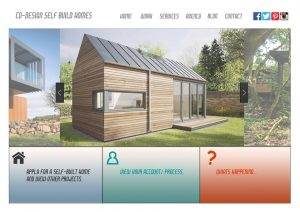Blog 4
Ⅰ How the goals going
The intimal project goal is ‘To make the co-design self-built homes become more accessible to people. Improving the current weakness of co-design self-built homes, finding a way to promote their ideas (like workshop/website) and then widening public’s community participation.’
Our goals are mainly stay at the same, however, we do some small changes reflected on our interview. As a team our aim is to provide and design a website and an app, through this platform we would help those people who are already involved in self build houses, to become more involve with the design processes.
- Detailed wants and wishes from the client. What are their aims and what they want to achieve?
- Provide some easy soft wears and make it easier to understandable for non-professional self-build through our app and website.
- Make a better link between our non-expert and expert such as (workshop, one to one contact, and online communication.
- Make the design process smoother to understand.
- Provide design concept e.g. 3D.
Ⅱ Search for relevant related project
Example1: Protor Homes
- This establishment takes the idea of self-building to a more self-chosen type of style.
- Proto homes take the self-build ideology to a more prefabricated manor.
- The organisation from the off go incorporates the customer with design. For example the customer chooses a pre-made design, and can edit to their own needs. Useful in thought that people can see the development of their homes designs and other self-build activities.
Example2: Site For Self-Build
- In addition, we thought the gallery would be a great concept when it comes to the sketch up. A gallery / portfolio of houses of which aspiring self-builders can look and choose depending on what they see fit. We thought that an interesting concept would be to have a more interactive design concept, which is where the sketch up idea came. Pre-designing houses over sketch up gives people great access and interaction with the design process as a whole.
- The way in which the company involves the customer is clear from the get go. The Home page of Proto Homes’ website provides a potential and current self-builders a whole catalogue of dated events. This therefore gives both consumer and organiser a whole platform of interaction. We feel that using a similar idea on the home page of the website would be useful.
- This organization is more of a platform to enable people to look at self-build organisations within their area.
- The group describe themselves as self-build creators and offer their professional services to individuals, groups and private enterprises.
- The organisation enables people to start and join self-build locations also, and have a large team enabling high quality of service.Also, the addition of blueprints and maps on their website is very useful. When it comes to the location of any build, it is important and also well worth doing research. We find that providing maps and location diagrams gives people understanding of that given self-build. Using Blueprints of the area, or potential blueprints, the consumers of the self-build project will understand that they can have influence on the project from the foundations.
- (Here is the initial design of the format of website)
- The website of Site For Self-Build had strong social links. Compared to the West End Housing Association, and Proto Homes we felt that Site 4 Self build has much clearer contact methods. The whole point of this project is to get people more involved with the design, and this is obviously done by contacts and connections. A strong and explicit few of methods of contact I feel is essential for this type of project to go ahead. Especially, the phone number. Giving that other self-build projects have out of country numbers such as the Proto homes, a recognisable number I feel would suggest clarity and trust too.

Hi team, thanks for this. Broadly you do cover the relevant content. For the final design log try to think about how and in which ways the interview with Gery and indeed conversations in the class (w teaching staff for example) may have influenced your revised goals. Perhaps try ask yourself what key turning points existed in the design process and what exactly made us change or leave our goals and how? It would also be good to hear you discuss how you worked this through within your team. Perhaps you could give voice to individual team members and how they may have influenced the revision of goals and what you may have discussed with the team with regards to goal setting.
This comment extends also to the example search. It’s good to see you have found two relevant examples. The design log could discuss in greater length how/who found those examples? Why are these examples useful? At present it is hard to understand what these examples (Proto home & Site for self-built) offer without knowing these examples in detail. So do follow practices of referencing, either by linking to these examples (if online resources are available) or by putting in a note of references used at the end.
I like your synthesise between Proto home and Site for Self-build, but perhaps you could expand this further, it seems that this may have been also a cause for you to set yourself some goals towards the prototype app/service you wanted to build and test. The discussion of contact numbers is a very important part in the discussion but it seems a bit hard to understand to the lay reader. Perhaps you could go back to the article by Maher to help you contextualise what you mean by ‘contact’. Is it perhaps better interaction and communication methods in relation to a development?
Maher, M. L., Paulini, M., & Murty, P. (2011). Scaling up: From individual design to collaborative design to collective design. Design Computing and Cognition’10, 581–599.